*This post may contain affiliate links. Read more »
There’s a reason why my daughter Özlem insists this is her favorite cold dessert of all time. This right here is the ultimate sago gulaman, loaded to the gosh darned brim with chewy sago pearls, and colorful gulaman cubes, drenched in a rich, caramel-like pandan syrup.This ice cold drink is the perfect antidote to hot summer heat, and the jellies are mad fun to eat. Oh god, that rhymed…
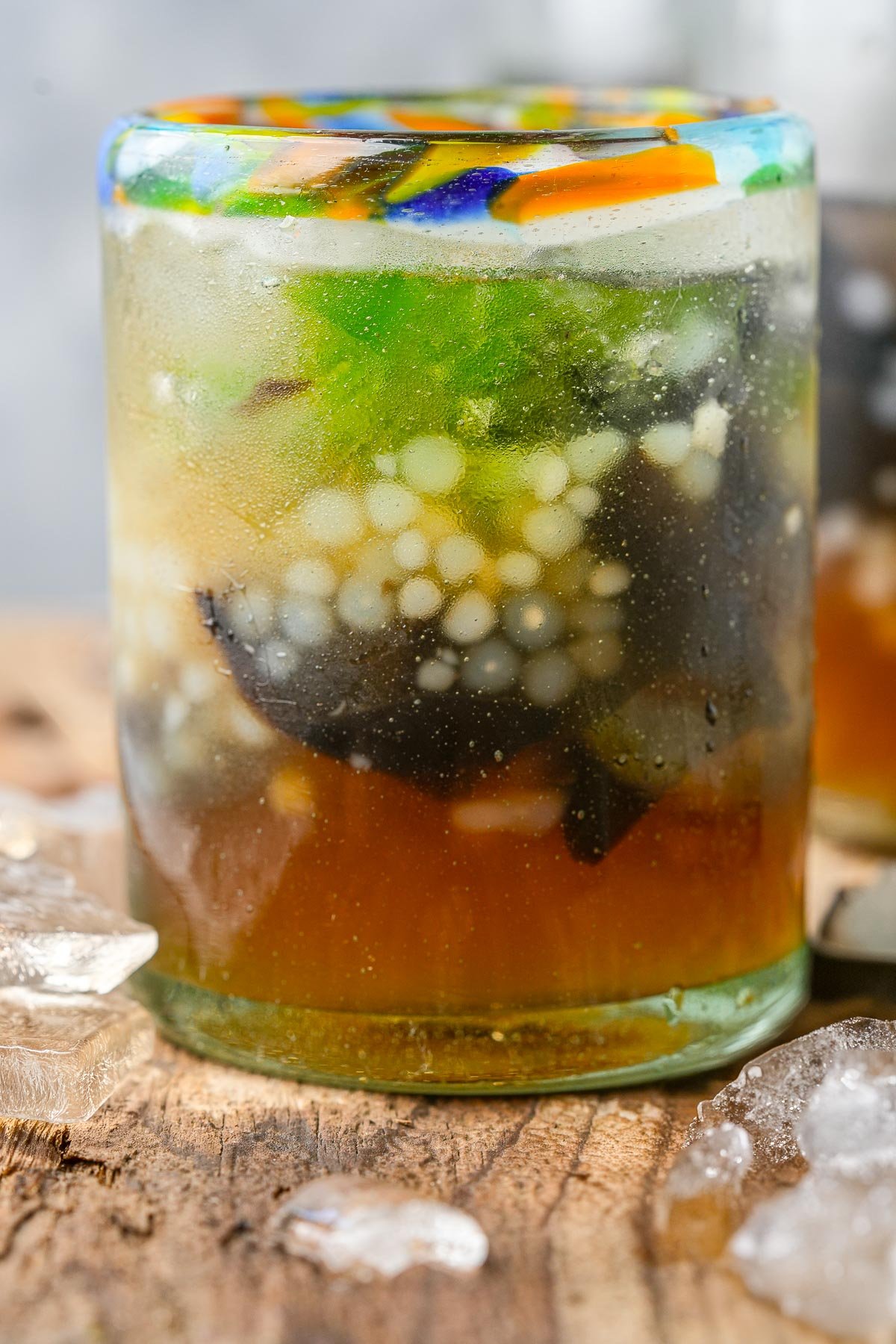

Enter your email & I'll send it to your inbox. Plus, get great new recipes from me every week!
By submitting this form, you consent to receive emails from Cinnamon Snail.
When I arrived in the Philippines to cook at the World Street Food Congress in Manilla alongside street vendors from all around the world, I had no idea we would be cooking in 105-110 degree heat for almost 18 hours a day, every single day, in a tent in the sun over a grill and steamer.
Luckily, some fans who fell in love with my food in NYC were working in Manilla and brought me cold local treats like sago’t gulaman, which is 100% the only reason I survived that even and am still here writing recipes today.
I’ve perfected this recipe so you can enjoy a traditional Sago’t Gulaman that's both authentic, simple-to-make, and 100% vegan. No need to scour the internet for hours – This recipe is designed to be foolproof, ensuring that you nail it on your first try. Get your sago pearls and gulaman ready, and let’s get this delightful drink in your overheated, shaky hands ASAP!
Jump to:
🤷♀️ What is gulaman?
In Filipino cooking, gulaman is the name given to thick jelly made from agar or carrageenan extracted from seaweed. Both of these sea veggies are polysaccharides (complex carbohydrates), which (don’t freak out) is why they are used as a jelling agent for making stuff like petri dishes and slants in science labs.
Anyway, I know I’m not helping the case that these are appetizing ingredients, but trust me they are super useful! Agar agar is used for tons of Southeast Asian desserts, like the Philippine’s famous buko pandan, and che ba mau from Vietnam. I also rely on the stuff to get the perfect consistency for my vegan creme brûlée and coconut panna cotta. See? I told ya. Those things are way yummier than petri dishes and whatnot.
Agar is sold in bars, flakes or powder form. If at all possible, get agar agar powder, as it is the easiest to accurately measure. It also dissolves more easily than other forms, preventing you from ending up with specs of gelatinous boogers throughout whatever you are making, which will probably make you mad, sad, and 100% not glad.
Gulaman has been a staple in Filipino cooking for centuries, with mentions dating back to the 1754 "Vocabulario de la lengua tagala." Gulaman powder is distinct from gelatin, as gulaman is plant-based, making it both vegan and kosher. Unlike gelatin, gulaman sets at room temperature and does not melt easily, making it a versatile ingredient in tropical climates.


🤫 Learn the secrets for perfect vegan Filipino meals
This guide to my most popular plant-based recipes from the Philippines is 100% FREE, & you'll love the actual heck out of it 🥰
🥰Why you'll adore this recipe
✊ Vegan AF & GF: Like all of my vegan Filipino recipes, this ice cold drinky-drink doesn’t harm a single living critter. Oh, and shocker: this is one of the gluten-free vegan recipes you can make for just about anyone and have them be 200% psyched.
🌱 Perfect Gulaman Texture: This recipe is perfectly dialed in for the jellies to be the best you have ever had. If you have ever had gulaman made with too much agar in them, you will know it’s a terrible culinary crime, and the person who made them should be put into an offshore kitchen prison where their desserts can’t harm the public ever again. But you? You will not be in such a prison because you found this recipe. So there’s that.
⏲️ Quick and Easy: This recipe comes together in under thirty minutes, making it perfies for cooling your steamy self down before you start to scream.
✅ Tested and Approved Worldwide: Like all the vegan recipes I share, after tweaking and perfecting it, I shared it with a truly massive team of recipe testers who replicated it successfully all around the world. Enjoy a tried-and-true fave that my tester think is super friggin’ good!
🧋Ingredients
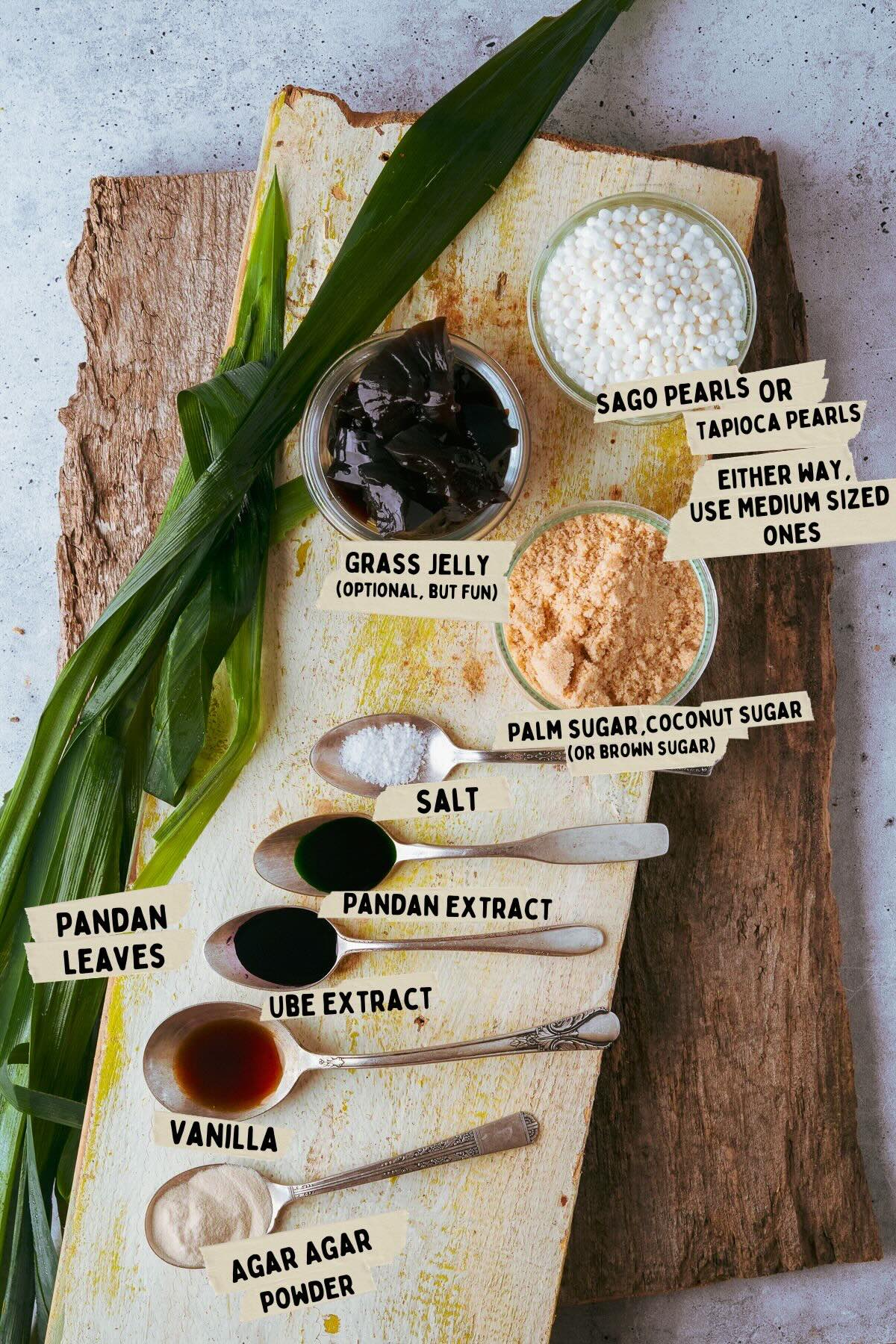
Sago Pearls
Sago and Tapioca are technically not the same thing, but they both can work in this recipe, provided you soak/boil them according to the instructions on your package. Any size you like will work, but my preference is for medium size, which are smaller than boba pearls you might use in Thai iced tea, but larger than the tiny ones you might make tapioca pudding with. Medium are the same size I mess with for making bubur cha cha.
Anyway, if you can't find sago, medium-sized tapioca pearls work as an excellent substitute.
Sugar
I like to use natural dark brown sugar of some kind for making sago’t gulaman, especially the arnibal syrup. My top choice, palm sugar, known as "gula melaka" in Southeast Asia, is also great for making biji salak and the filling for ondeh ondeh. Otherwise, if that’s tricky to get, coconut sugar, or regular ol’ brown sugar will work great in this recipe too.
Agar Agar
Agar agar powder is a fantastic plant-based alternative the gelatin, which is made from seaweed and is a popular ingredient in Asian desserts. It's produced by boiling and drying red algae, producing a mostly tasteless and odorless gelatin substitute. If agar agar powder is not available, you can substitute it with agar agar flakes or Irish moss, but be very thorough in dissolving those to give your jellies a similar texture.
Ube Extract (Optional)
I lu-lu-luhrve the flavor of ube, which is why I even like to glaze my karioka (Filipino mochi donuts) with the darned stuff. You don’t HAVE to use ube in this recipe at all, but I like dividing my gulaman while it’s still liquid and giving half of it the flavor and pretty color of purple yam. Can’t find it, or hate ube with all your heart? Just make all of the gulaman pandan flavored instead. No biggy.
Grass Jelly (Optional)
Grass jelly, also known as "cincau" in Southeast Asia, is an herbal jelly made from the leaves of the Mesona plant. It's slightly bitter, maybe a little bit “swampy” tasting, so don’t eat it plain. Trust me, on it’s own- it sucks. But when its mild, earthy taste gets doused in the sweet arnibal syrup, the fun texture is a great addition to this dessert.
*See the recipe card at the bottom of the page for exact quantities, nutritional info, and detailed cooking directions.
🤯Variations
With Sweet Corn and Coconut Milk:
For a richer, more tropical flavor, try adding cooked sweet corn kernels and a splash of coconut milk to the arnibal syrup.
Black Gulaman Drink:
In some regions, Sago Gulaman is made with a combination of brown sugar and molasses for a deeper, more intense caramel flavor and darker color. A ton of folks also use some banana extract, but I can’t stand that stuff. I worked at a restaurant (not naming any names) that used banana extract in some of their cakes, and I always thought banana essence tasted like weird artificial bubble gum or something. Not for me, but this is your dessert, so I can’t stop ya, right?
Mango Sagot Gulaman:
Use mango extract in the jellies in place of pandan, or simply add diced fresh mangos to the finished drink. Just make sure to cust them small enough not to clog your bobba straw.
📖 How to make it
Nail this frosty filipino drink on your first shot by following these step-by-step photos with helpful tips. Or scroll down to the bottom of this page for the easy-to-print recipe card.
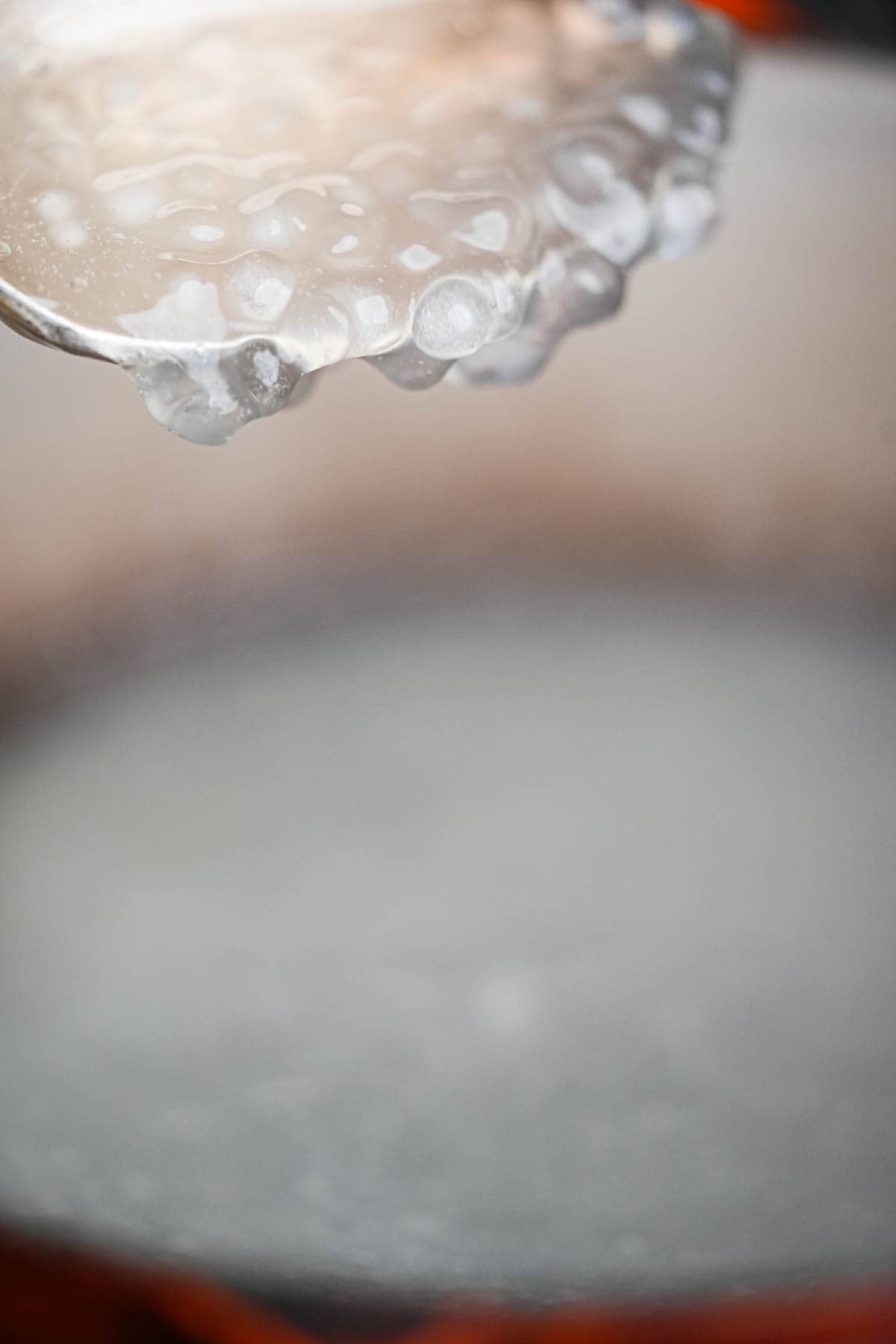
Step One
My Pearls, my Precious Pearls!
Bring 12 cups of water to a boil over high heat. Once the water is boiling, Add the sago or tapioca pearls, stirring occasionally to keep them from sticking.
Reduce the heat to medium and simmer for twenty minutes. Turn off the heat, cover the pot, and let the pearls sit for ten minutes. Drain and rinse the pearls in a wire mesh strainer under cold water, then set aside.
✅ If you are using tapioca or sago pearls that are not medium size, follow the instructions on your pancakes to get them cooked perfectly.
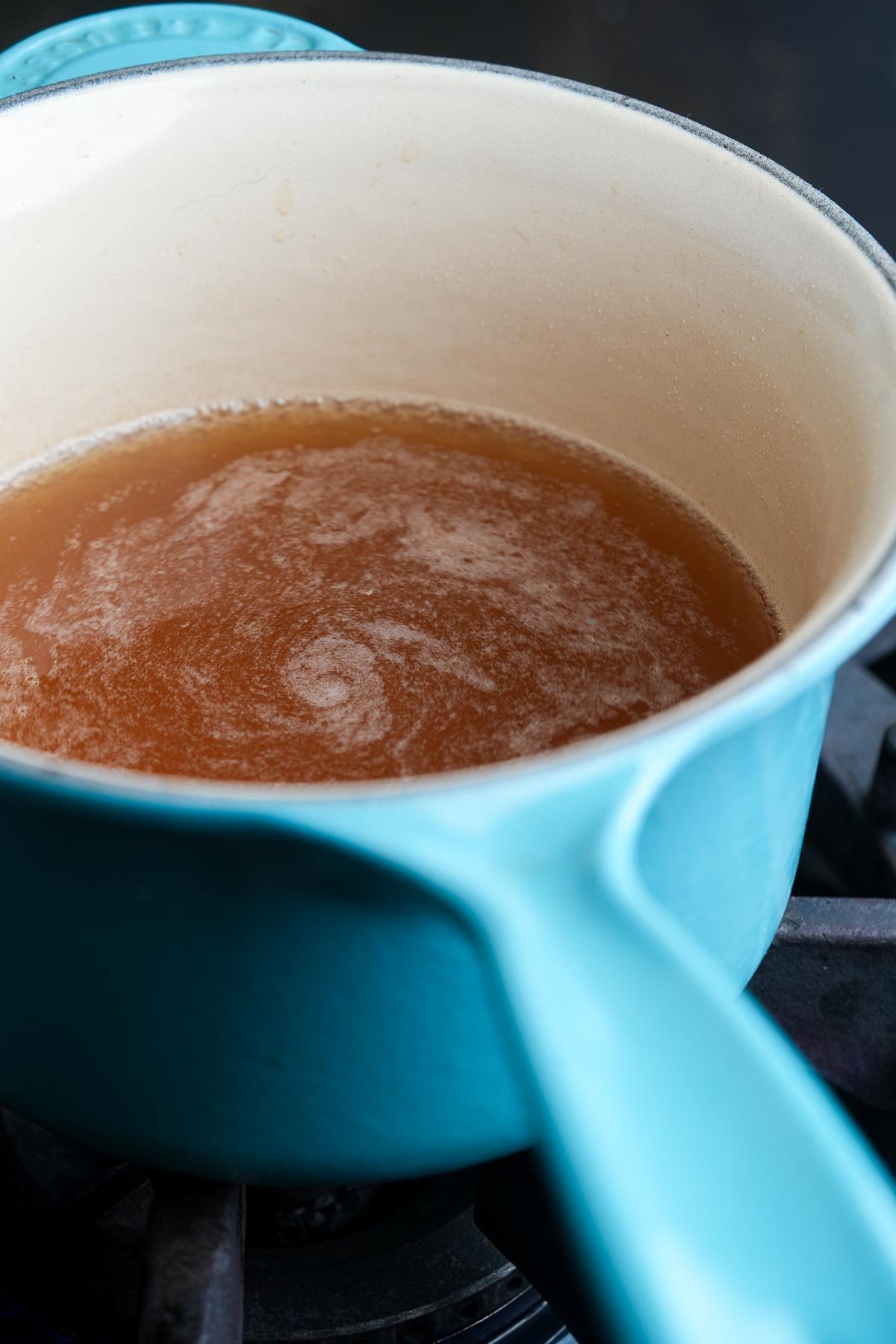
Step Two
Jelly Garcia:
Using a whisk, mix together two cups of water, palm sugar, agar-agar powder, and salt in a separate pot. Bring to a boil over medium heat, stirring frequently, just until it comes to a boil and the sugar and agar-agar dissolve.
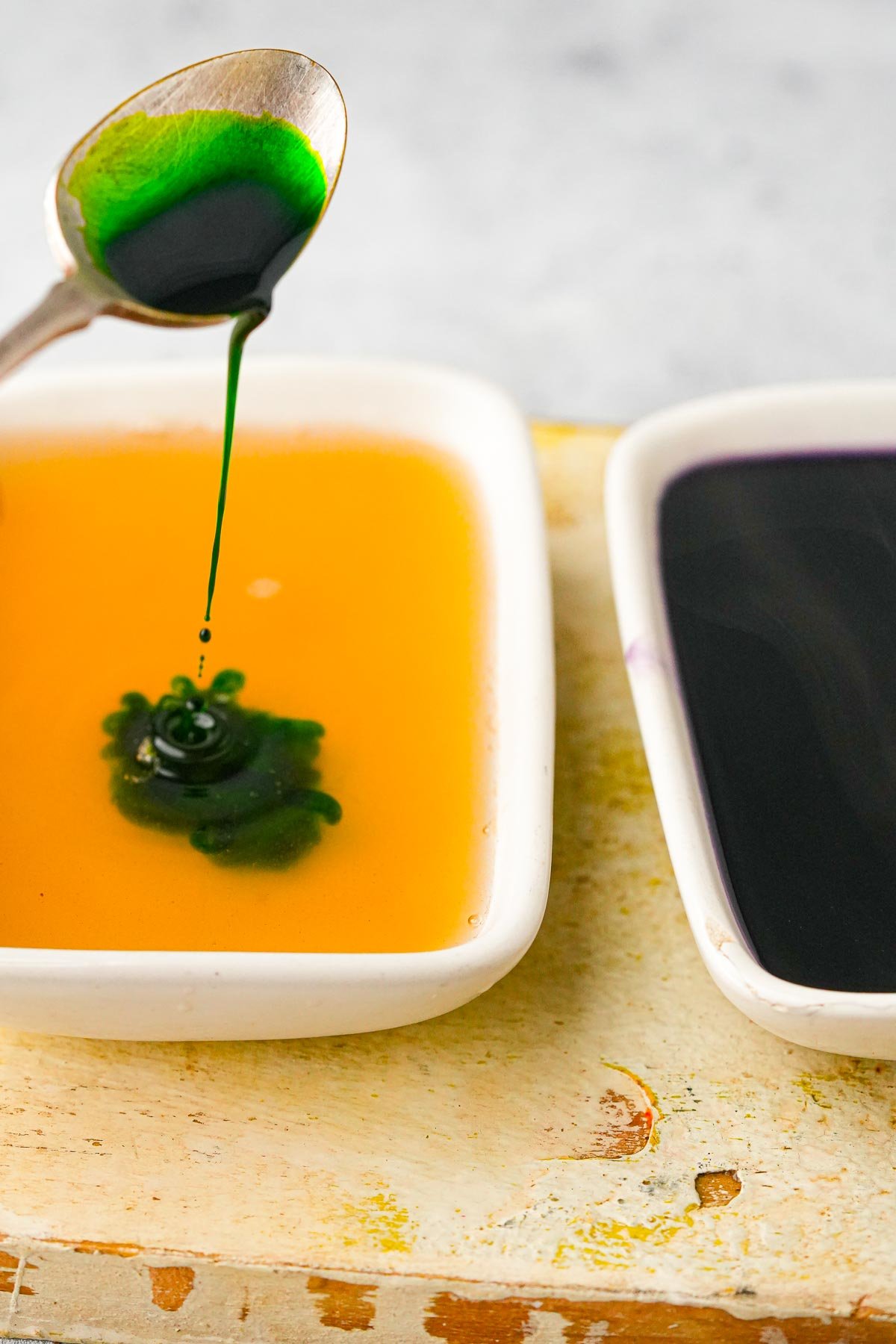
Step Three
Divide and Conquer:
Divide the mixture into two bowls. Add pandan extract (or buko pandan flavor) to one bowl and ube extract to the other. Allow the mixtures to cool slightly, then refrigerate until firm.
✅If you are in a hurry, this will set up faster in the freezer.
✅ You don’t have to divide and flavor the gulaman in two different ways. If you are just using one extract, you can mix it right into the gulaman in the pot and then chill it just like that.
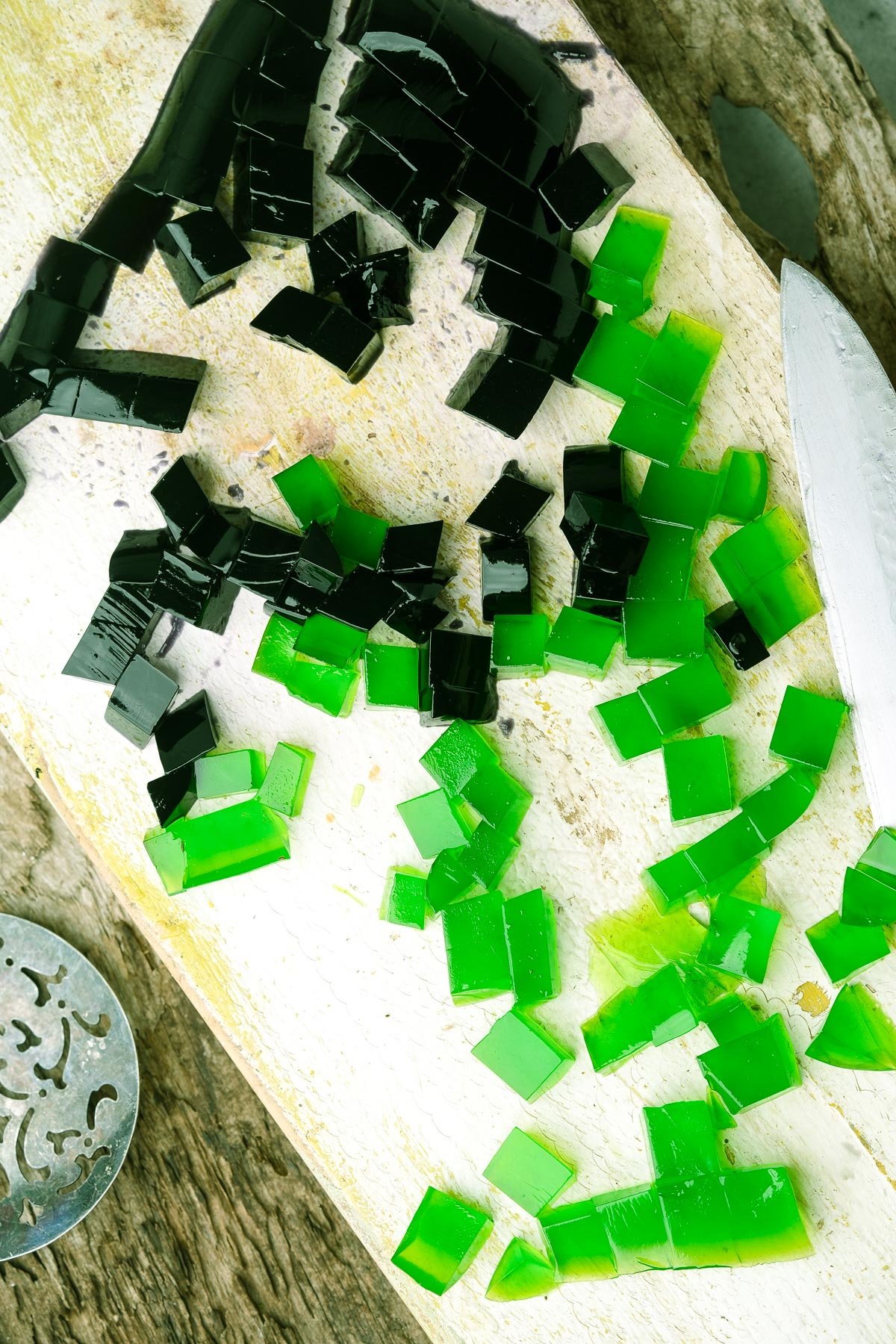
Step Four
Cube Libre:
Once the gulaman jelly has chilled and become firm, cut it into small cubes and set aside.
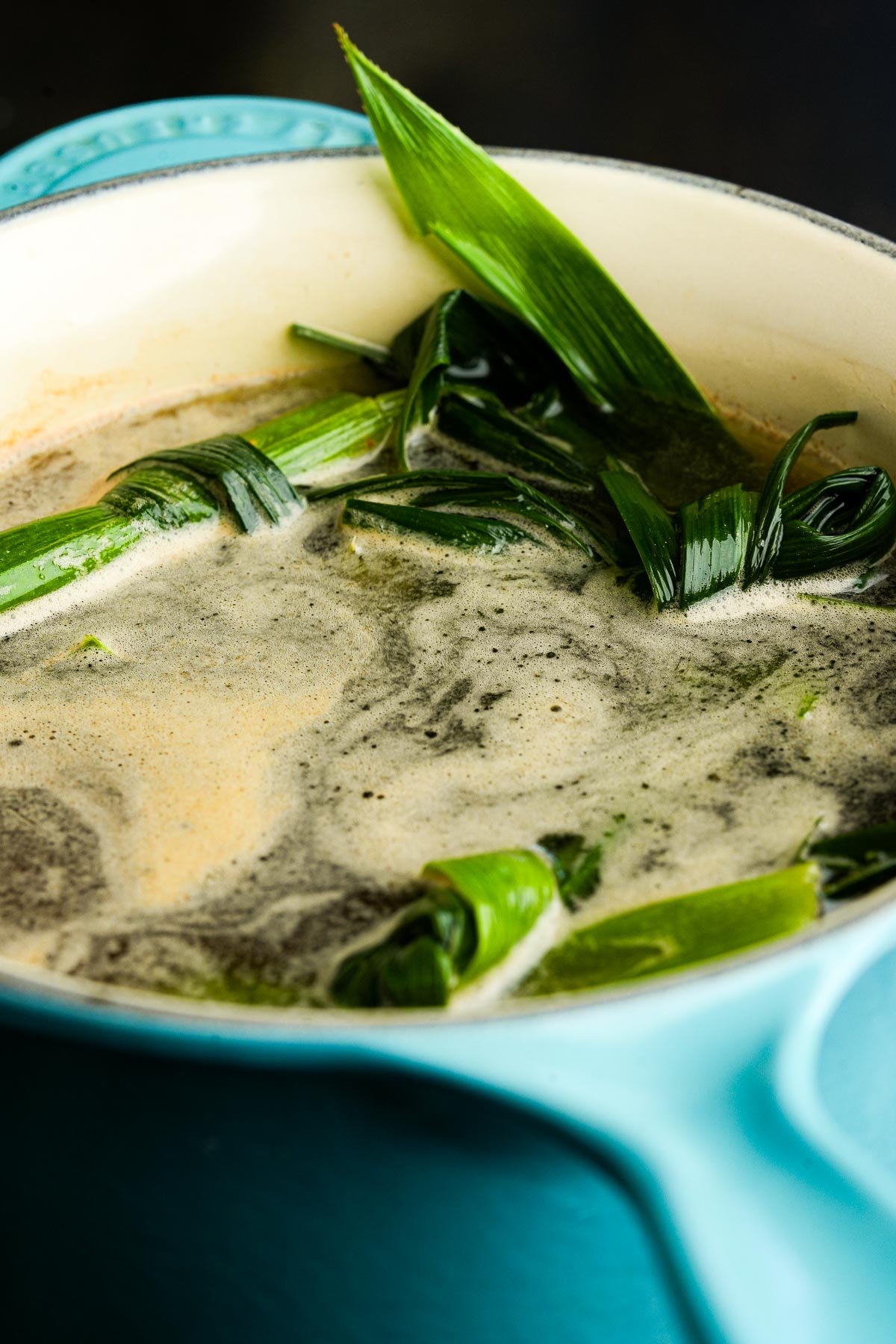
Step Five
Syrup Up and Away!
Bring 3 cups of water and pandan leaves to a boil over medium heat. Add palm sugar and vanilla extract, stirring until completely dissolved.
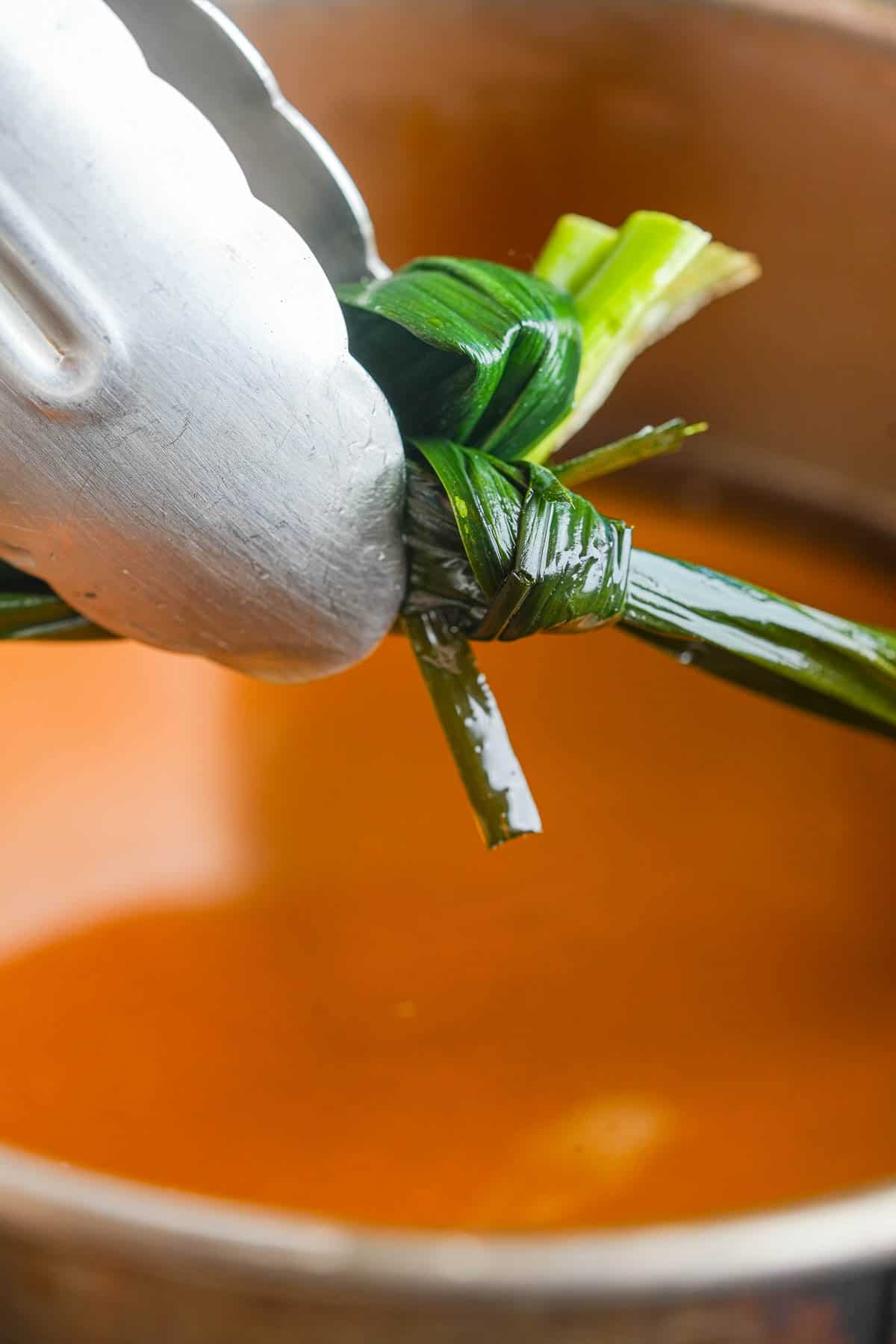
Step Six
Go Away, Grass:
Once the pot has come to a boil, remove from heat and discard the pandan leaves. Let the syrup cool to room temperature.
✅When you remove the pandan leaves, make sure to squeeze as much arnibal syrup out of them as possible. The juice that’s all up in the leaves will be the most flavorful of all.
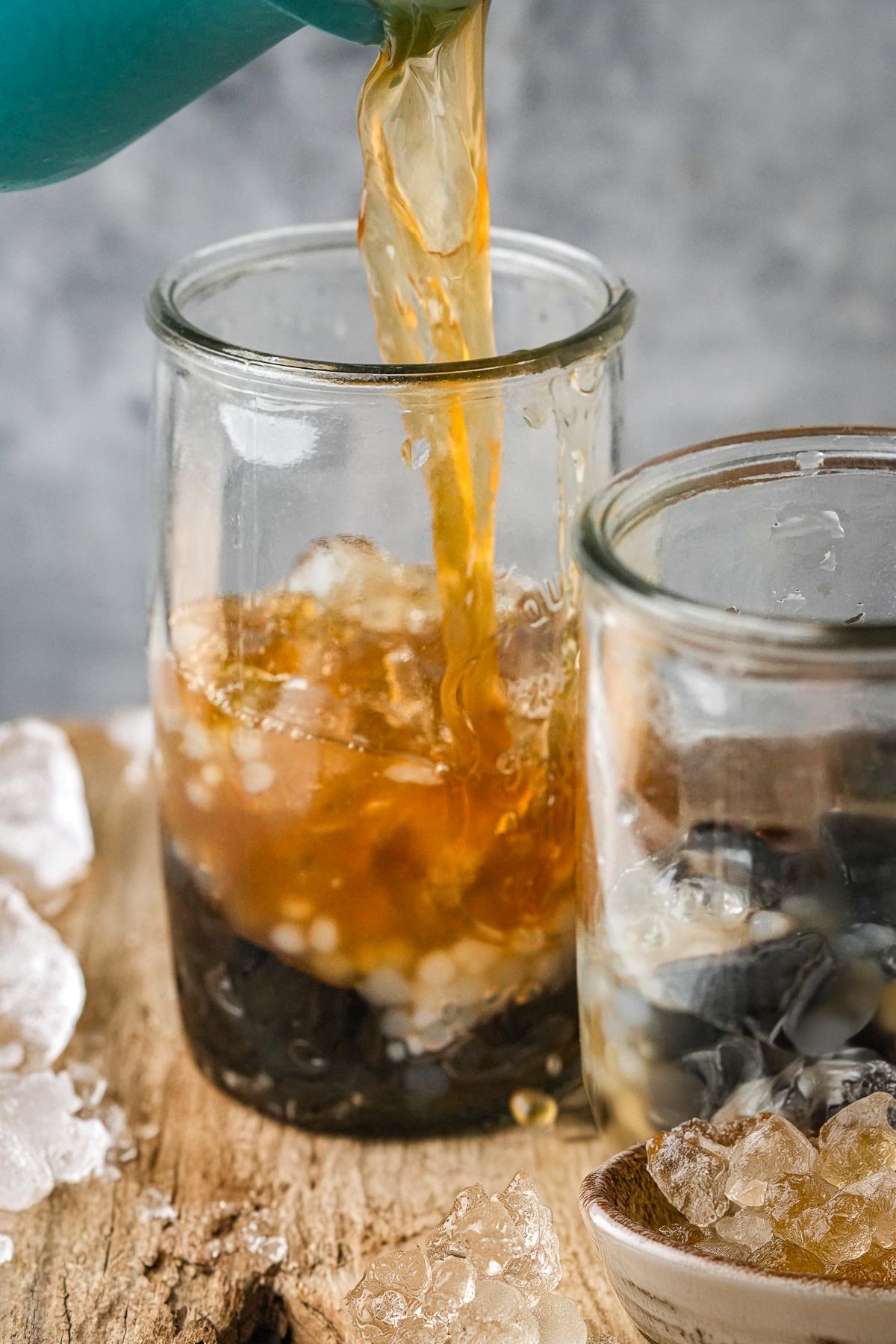
Step Seven
Assemble the Glorious Drinky:
Place some ice at the bottom of each tall glass. Layer the sago or tapioca pearls over the ice. Add chopped grass jelly if desired. Pour the cooled brown sugar syrup over the pearls, then top with more ice. Add the pandan and ube jelly cubes. Serve immediately, cold enough to chill your entire brain.
💡Serving Ideas
Sago gullaman is a lovely light alternative to heavier Filipino desserts like turon, suman malagkit, and tupig.
But dessert? Doesn’t that mean you have to eat a proper meal first? (I mean, according to my wife, no. No it does not).
But, if you want to be my lover, you gotta get with my friends like sitaw without pork in it. I’ve also cooled down with sago gulaman after a meal of ginataang langka or kalabasa with ginisang munggo over tom yum fried rice. This is a hyper-nourishing feast of filipino goodness, that’s only made better with iconic lumpiang Shanghai. Get cooking, my dear mommy!
👉Top Tips
- Perfect Pearl Texture: Make sure to stir the sago or tapioca pearls from time to time while boiling to prevent clumping, or sticking to the bottom of the pot. Only strain and rinse the pearls when they are almost entirely clear.
- Agar-Agar Activation: When dissolving agar-agar powder, ensure the mixture reaches a rolling boil. Agar-agar needs to be boiled to activate its gelling properties fully.
- Even Set Up: Don’t pour the liquid gulaman into a bowl to chill. Use something with a flat bottom, and ideally straight sides so that your jellies can be the same thickness and size. That way, if you drink sago gulaman with a wide boba straw, it will not get clogged with stuck gulaman pieces.
- Balance Sweetness with Tons of Ice: Don’t be shy about using a an absurd amount of ice. You not only want the drink to be cold, but you want the melting ice to make this not-insanely sweet, right?
🤷♀️ Recipe FAQs
Store Sago Gulaman with all of the components in separate containers in the refrigerator. The tapioca pearls can be stored in water so they don’t stick together. That way when you want to serve sago gulaman, its will not be diluted from melted ice.
Make sure you bring the agar-agar mixture to a full boil to activate its gelling properties. Then when you chill the gulaman, make sure you set it up in a container with a flat bottom, not a bowl that will have varying depths.
Stir the sago pearls frequently while cooking and rinse them under cold water after draining. This helps remove excess starch and prevents clumping. If storing, keep them in water.
😍You will also LOVE these:
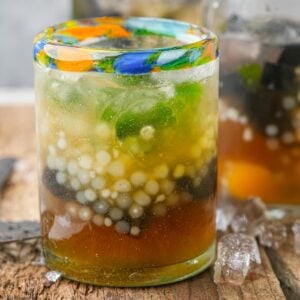
Sago't Gulaman Recipe (Refreshing Filipino Sago Drink)
Equipment
Ingredients
For the sago, or/ tapioca pearls:
- ⅔ cup sago pearls medium size, or medium tapioca pearls
- 12 cups water
For the gulaman:
- 2 cups water
- ⅓ cup palm sugar coconut sugar, or brown sugar
- 1 teaspoon agar-agar powder
- ¼ teaspoon salt
- ½ teaspoon pandan extract
- ½ teaspoon ube extract optional
For the arnibal syrup:
- 3 cups water
- 6 pandan leaves or 1 teaspoon pandan extract
- 1½ cups palm sugar coconut sugar, or brown sugar
- ½ teaspoon vanilla extract
Other fun stuff:
- 1 cup chopped grass jelly optional
- 4 cups ice
Instructions
- Bring a large pot of water to a boil over high heat. Add the sago or tapioca pearls and stir occasionally to prevent sticking. Reduce the heat to medium and simmer for twenty minutes. Turn off the heat, cover the pot, and let the pearls sit for ten minutes. Drain and rinse the pearls under cold water. Set aside.
- In another pot, combine two cups of water, palm sugar, agar-agar powder, and salt. Bring to a boil over medium heat, stirring frequently until the sugar and agar-agar dissolve.
- Once dissolved, divide the mixture evenly into two bowls. Add pandan extract to one bowl and ube extract to the other. Allow the mixtures to cool slightly, then refrigerate until firm.
- Once set, cut the jelly into small cubes.
- For the arnibal syrup, bring three cups of water and pandan leaves to a boil over medium heat. Add palm sugar and vanilla, and stir until completely dissolved. Remove from heat and discard the pandan leaves. Llet the syrup cool to room temperature.
- To assemble, place some of the ice at the bottom of each glass. Layer the sago or tapioca pearls over the ice. Add chopped grass jelly if using. Pour the arnibal syrup over the pearls, then top with ice. Add the pandan and ube jelly cubes. Serve immediately.
Notes

Enter your email & I'll send it to your inbox. Plus, get great new recipes from me every week!
By submitting this form, you consent to receive emails from Cinnamon Snail.




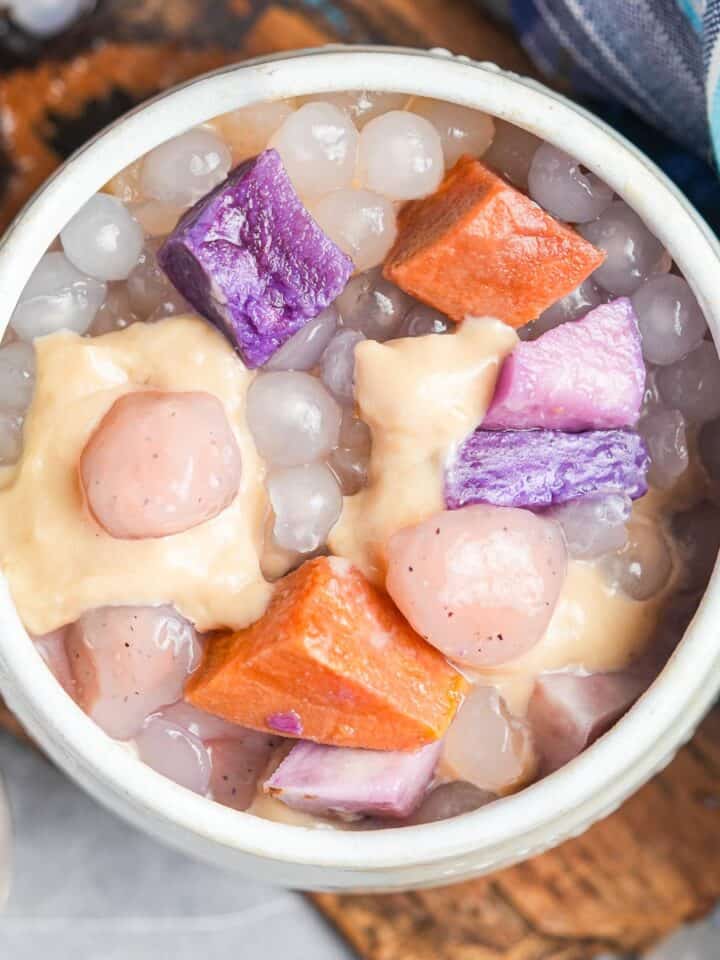


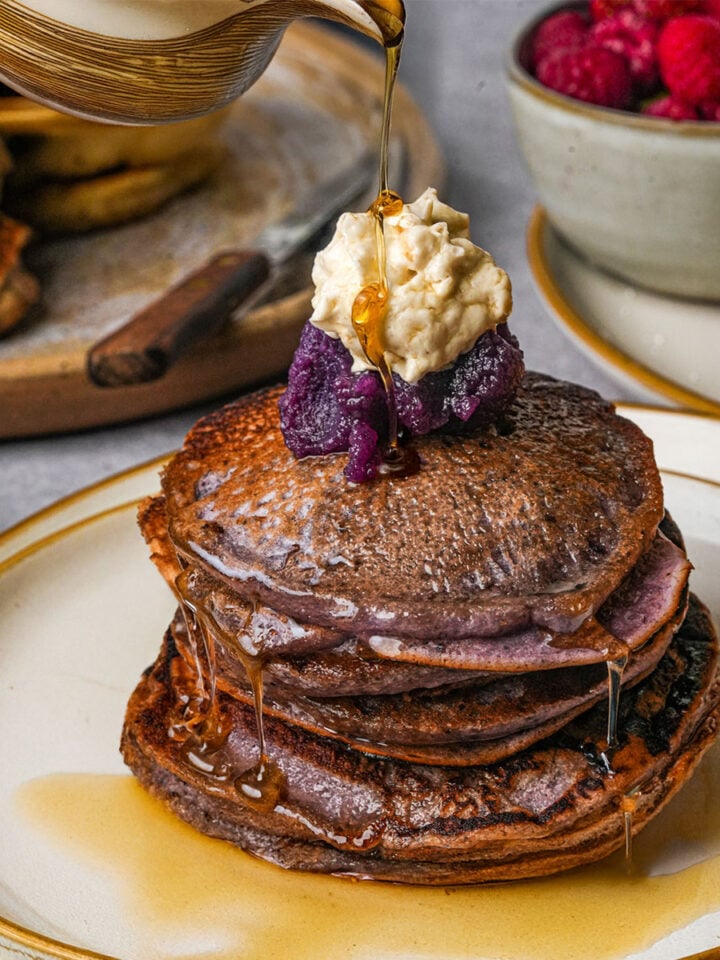



hg says
This was one of the more unique things I've ever made. I don't travel abroad much, do it was a nice way to bring the Philippines to me. A regressions drink with so many colors and textures. Not only delicious, but attractive too. Great way to impress guests.